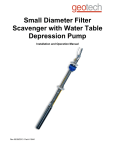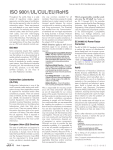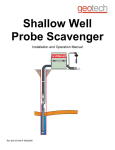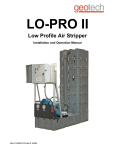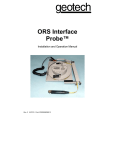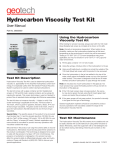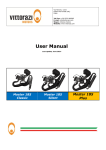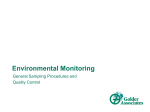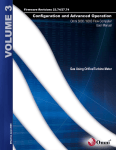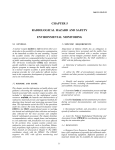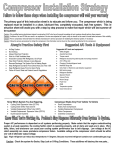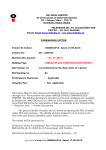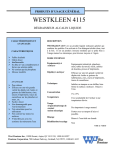Download ORS Filter Bucket: User Manual
Transcript
ORS Filter Bucket Operation and Maintenance Manual Rev. 3 12/09/02 Part # ORS999004003 Table of Contents Chapter 1: System Description...................................................................................................... p. 05 Function and Theory................................................................................................................... p. 05 System Components .................................................................................................................. p. 06 Chapter 2: System Installation....................................................................................................... p. 07 Chapter 3: System Operation ........................................................................................................ p. 08 Chapter 4: System Maintenance ................................................................................................. p. 010 Chapter 5: System Troubleshooting ............................................................................................ p. 011 Chapter 6: System Specifications................................................................................................ p. 012 Chapter 7: System Schematic ....................................................................................................... p. 15 Chapter 8: Replacement Parts List................................................................................................ p. 16 Warranty and Repair ...................................................................................................................... p. 19 1 Chapter 1: System Description Function and Theory The ORS Filter Bucket™ is an independently floating passive oil-water separator that is equipped with a visual alarm to indicate when the bucket is full of product. The heart of the system is a floating cartridge that recovers product for storage in an integral 2-liter reservoir. Actual separation of product from water is carried out by a mesh screen located in the cartridge. This screen is specially treated to pass oil and repel water. The screen is therefore termed oleophilic/hydrophobic (oil loving /water hating). 2 System Components Visual Alarm Cover Handle Reservoir Cartridge Product Hose ¼” Teflon Check Valve Ball (located inside elbows) Figure 1 3 Chapter 2: System Installation The bucket is placed in a sump, pond, or other body of water. It is easily deployed by holding the circumferential handle. The bucket and the cartridge will float as shown in figure 2. As it progressively fills, the bucket will sink into the water while the cartridge floats at a level (See figure 4). When the bucket is full, remove it by its handle. Unscrew the cover and pour the product into a suitable receptacle. Clean off the cartridge if necessary. The cartridge surface is best cleaned with a nylon toothbrush and clean fuel. Care should be taken to remove debris without pushing it through the screen. Never clean with detergents, surfactants, or unknown solvents. If the ORS Filter Bucket™ is left floating on water with little or no hydrocarbon present; the screen may eventually pass water and cause the bucket to sink. As a precaution against this possibility, tether the bucket by attaching a cord to the lifting handle. Attach the other end of the cord to the edge of the well or pond. 4 Chapter 3: System Operation When properly deployed, and before product has accumulated in the reservoir, the ORS Filter Bucket™ should sit in the water as shown in figure 2. As product passes through the cartridge, it falls into one of the two hoses and is gravity fed through the bucket wall and through a small check valve. When the cover of the bucket is removed, product can be seen flowing into the bucket. The rate of flow into the ORS Filter Bucket™ is dependent upon the viscosity of the product and the thickness of the slick (See System Specifications). As product accumulates in the reservoir, the ORS Filter Bucket™ will ride lower in the water as shown in figure 3. At the same time, the product level indicator shaft will be extended through the top of the bucket. The ORS Filter Bucket™ is designed so that the reservoir will cease taking on product just as the cartridge contacts the bucket handle. 5 Scene A Oil Level Water Figure 2 Scene B Oil Level Water Figure 3 Scene C Oil in Reservoir Water Figure 4 6 Chapter 4: System Maintenance The only maintenance required is periodic cleaning of the cartridge screen. 7 Chapter 5: System Troubleshooting If the ORS Filter Bucket fails to perform properly, check components listed in Chapter 8 of this manual for visual damage, clogging due to debris, cracking or any other damage. Also, technical support is available by contacting Geotech Environmental Equipment at 1-800-833-5978 or (303) 320-4764. 8 Chapter 6: System Specifications 9 System Limitations As with all systems, the ORS Filter Bucket™ is limited by its components. These restrictions are classified into water product type recovered. 10 Water Parameters The water parameters are classified into physical, chemical, and debris divisions. Physical State The bucket is designed as a surface follower to minimize its heave and pitch. When the water is rough due to current or wind conditions, the effect is to reduce the ability of the cartridge to repel water. Under certain conditions, the cartridge will pass water. The slight density difference between product and water is inconsequential for the buoy flotation. If the unit is used exclusively in sea water, certain parts may eventually require replacement due to salt water corrosion. Chemical State Detergent or surfactant concentrations greater than 100 ppm (grams/liter) may cause the cartridge to pass water. Also, if the ORS Filter Bucket™ is placed in an area with no product to “wet” the screen, a natural biological film will coat the screen and reduce its ability to repel water. Since this biological build-up (or fouling) is accelerated by warm temperatures, the cartridge will pass water more easily during the summer or in tropical environments. In general, oil/water emulsions will pass through the cartridge screen, and the extent of this problem is related to the relative amounts of product and water present. The oil/water interface always has both emulsion types present as well as high concentrations of surfactant. Whenever the ORS Filter Bucket™ is deployed in thin layers of product, some water may pass through the cartridge. Debris Presence of debris at the oil/water interface may reduce the product flow rate. Most debris accumulates on the mesh when a large volume of product entering the cartridge. Debris is easily removed when cleaning the cartridge. Often, the unit may be gently pulled up and down in its site area to remove some of the accumulated debris. Product Type Recovered The ORS Filter Bucket™ will recover any non-polar liquid whose density is less than that of water. This leaves out such dense materials as chloroform, carbon disulfide, carbon tetra-chloride and Freon. Certain materials will dissolve the housing and cartridge seals, but the unit may be used in an emergency or if concentrations of such materials are low. These materials are usually aromatics: common ones are benzene, xylene, toluene and styrene monomer. Materials that can readily be recovered include gasoline, kerosene, oils, hexanes, heptanes, octanes, petroleum, napthas, pentanes, or mixtures of the above. 11 Chapter 7: System Schematic 12 Chapter 8: Replacement Parts List Part Number Part Description 10097 PPP001058 00355 2040002 2040003 2040005 ORS999004003 Ball, TFE, ¼” PVC Fuel Hose Check Valve 100 Mesh Cartridge Assembly 60 Mesh Cartridge Assembly Closure Assembly Operation Manual 13 Decontamination Procedures Some common decontamination solutions are listed below along with the contaminants they are effective against: Solution Effective Against Water Dilute Acids Dilute Bases Organic solvents Short-chain hydrocarbons, inorganic compounds, salts, some organic acids, other polar Basic (caustic or alkaline) compounds, amines, hydrazines. Acidic compounds, phenols thiols, some nitro- and sulfonic compounds. Non-polar compounds (such as some organic compounds) compounds. The use of organic solvents is not recommended because: 1) Organic solvents can permeate and/or degrade the protective clothing and 2) they are generally toxic and may result in unnecessary employee exposure to hazardous chemicals. When in doubt, use a dish washing liquid detergent. As a decontamination solution, it is readily available, is the safest of all the above, and is usually strong enough if used generously. The use of steam can also be effective for decontamination. A water-lazer (pressurized water) is exceptionally valuable. The following substances are noted for their particular efficiency in removing certain contaminants or for decontaminating certain types of equipment. Solution Effective Against Penetone PCB Contamination (since penetone may also remove paint, it is a good idea to spot-test before use) Liquinox Contaminated pumps Ivory liquid Oils Diluted HTH Cyanides Radiac Low level radioactivity Isopropanol Biological agents (should not be used on rubber products since it will break down rubber) Hexane Certain types of lab or sampling equipment (use of hexane is discouraged due to its flammability and toxicity) Zep General purpose cleaning Alconox General purpose cleaning Decontamination Solutions to Avoid Some decontamination solutions should be avoided because of their toxicity, flammability, or harmful effects to the environment. Halogenated hydrocarbons, such as carbon tetrachloride, should not be used because of their toxicity, possible incompatibility, and some because of their flammability. Organic decontamination solutions should not be used on personal protective equipment (PPE) because they may degrade the rubber or other materials comprising the PPE. Mercurials are sometimes used for sterilization. They should be avoided because of their toxicity. Chemical leaching, polymerization, and halogen stripping should all be avoided because of possible complications during decontamination. Sand-blasting, a method of physical removal, should be avoided because the sand used on the contaminated object usually needs to be disposed of as hazardous waste, a very costly proposition. Also, sand-blasting exposes personnel to silica, a carcinogen. Freon is known to be particularly effective for the cleansing of PCB's but its effect on the ozone layer is extremely harmful. Its use is discouraged. Strong acids or bases should not be used when cleaning metals and gaskets or tools or other equipment because of the possibility of corrosion. 14 Disposal of Decontamination Solutions and Waste Water All solutions and water used for decontamination must be collected. If lab analysis indicates that the water and/or solutions exceed allowable contamination levels, they must be treated as hazardous waste. Alternatively, the solutions and water may be treated on-site to lower the contamination levels and render them non hazardous. Containers such as 55-gallon drums should be available for storage of wastes. Spent decontamination solutions can be collected by using heavy-duty plastic sheets, visqueen sheets, kiddie pools, or if needed, a larger containment basin. The decontamination of equipment must be performed on the sheets or in the basins. They could be placed on a slight angle so that the spent decontamination solutions drain into a collection basin or drum. Recommended Supplies for Decontamination of Personnel, Clothing and Equipment The list below contains recommendations for supplies which would be on hand for the decontamination of personnel, clothing and equipment. Depending on the site activities, not all of these items may be needed. Alternatively, some additional items not listed here may be required. • Drop cloths of plastic or other suitable material, such as visqueen, for heavily contaminated equipment. • Disposal collection containers, such as drums or suitably lined trash cans for disposable clothing and heavily contaminated personal protective clothing or equipment to be discarded. • Lined box with adsorbent for wiping or rinsing off gross contaminants and liquid contaminants. • Wash tubs of sufficient size to enable workers to place booted foot in and wash off contaminants (without a drain or with a drain connected to a collection tank or appropriate treatment system). • Rinse tubs of sufficient size to enable workers to place booted foot in and wash off contaminants (without a drain or with a drain connected to a collection tank or appropriate treatment system • Wash solutions selected to wash off and reduce the hazards associated with the contaminated wash and rinse solutions. • Rinse solution (usually water) to remove contaminants and contaminated wash solutions • Long-handled, soft-bristled brushes to help wash and rinse off contaminants. • Lockers and cabinets for storage of decontaminated clothing and equipment. • Storage containers for contaminated wash and rinse solutions. • Plastic sheeting, sealed pads with drains, or other appropriate method for containing and collecting contaminated wash and rinse water spilled during decontamination. • Shower facilities for full body wash or at a minimum, personal wash sinks (with drains connected to a collection tank or appropriate treatment system). • Soap or wash solution, wash cloths and towels. • Clean clothing and personal item storage lockers and/or closets. 15 The Warranty For a period of one (1) year from date of first sale, product is warranted to be free from defects in materials and workmanship. Geotech agrees to repair or replace, at Geotech’s option, the portion proving defective, or at our option to refund the purchase price thereof. Geotech will have no warranty obligation if the product is subjected to abnormal operating conditions, accident, abuse, misuse, unauthorized modification, alteration, repair, or replacement of wear parts. User assumes all other risk, if any, including the risk of injury, loss, or damage, direct or consequential, arising out of the use, misuse, or inability to use this product. User agrees to use, maintain and install product in accordance with recommendations and instructions. User is responsible for transportation charges connected to the repair or replacement of product under this warranty. Equipment Return Policy A Return Material Authorization number (RMA #) is required prior to return of any equipment to our facilities, please call 800 number for appropriate location. An RMA # will be issued upon receipt of your request to return equipment, which should include reasons for the return. Your return shipment to us must have this RMA # clearly marked on the outside of the package. Proof of date of purchase is required for processing of all warranty requests. This policy applies to both equipment sales and repair orders. FOR A RETURN MATERIAL AUTHORIZATION, PLEASE CALL OUR SERVICE DEPARTMENT AT 1-800-833-7958 OR 1-800-275-5325. Model Number: ________________ Serial Number: ________________ Date: ________________ Equipment Decontamination Prior to return, all equipment must be thoroughly cleaned and decontaminated. Please make note on RMA form, the use of equipment, contaminants equipment was exposed to, and decontamination solutions/methods used. Geotech reserves the right to refuse any equipment not properly decontaminated. Geotech may also choose to decontaminate equipment for a fee, which will be applied to the repair order invoice. Geotech Environmental Equipment, Inc th 8035 East 40 Avenue Denver, Colorado 80207 (303) 320-4764 ● (800) 833-7958 ● FAX (303) 322-7242 email: [email protected] website: www.geotechenv.com





















